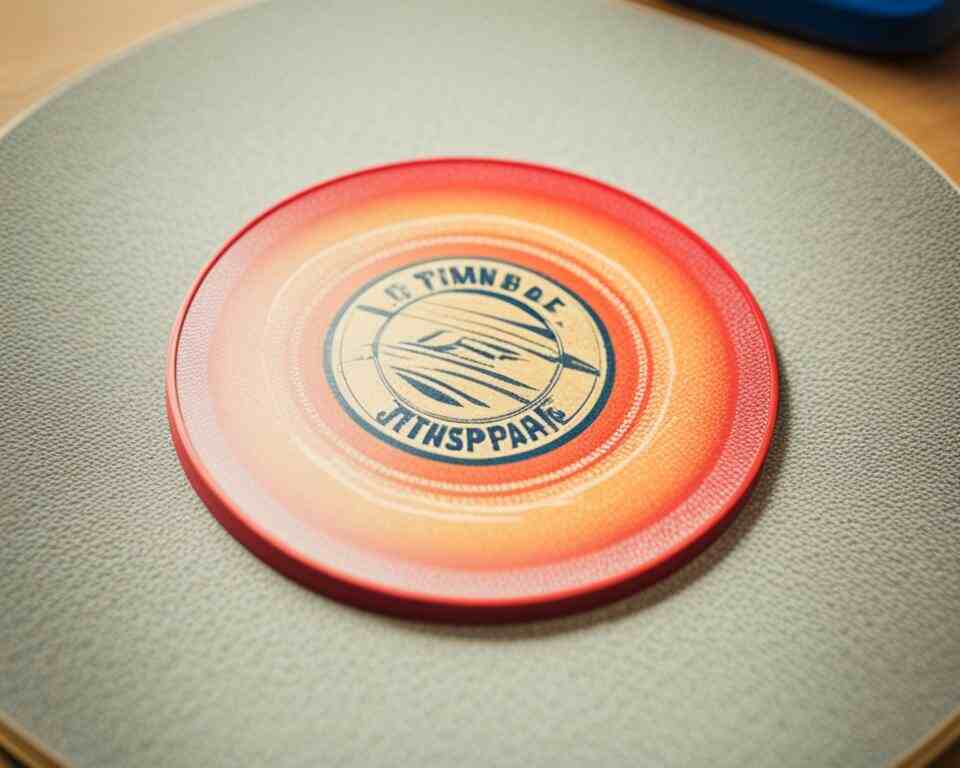Disc golf discs require regular maintenance to ensure their optimal performance and longevity. As a disc golfer, one practice that often comes to mind is sanding disc golf discs. But is it really a good idea? Let’s explore the pros and cons of sanding discs, along with the essential aspects of disc golf disc maintenance that every player should consider.
Key Takeaways:
- Sanding disc golf discs can be an effective way to improve grip and remove imperfections.
- However, sanding discs may alter their flight characteristics, potentially affecting performance.
- Proper disc golf disc care, including cleaning and repairs, is crucial for maintaining optimal performance.
- Always follow the rules set by the Professional Disc Golf Association (PDGA) regarding disc modifications.
- Choose the right sandpaper and techniques to sand discs without compromising their flight characteristics.

Can You Sand Disc Golf Discs: Exploring the Legality
When it comes to disc golf disc maintenance, one common practice that players consider is sanding their discs. However, before diving into sanding techniques, it’s essential to understand the legality of disc modification. The Professional Disc Golf Association (PDGA) has established rules regarding post-production disc modifications, specifically those that alter the original flight characteristics of the disc.
PDGA Rules on Disc Modification
The PDGA, as the governing body of disc golf, has strict guidelines in place to maintain fair and competitive play. According to the PDGA rules, disc golf discs must be played in their original, manufactured state. Any modifications that affect the disc’s original flight characteristics, such as sanding, are not allowed during sanctioned tournaments.
However, it’s important to note that some minor alterations are permitted, such as smoothing out scratches or wear on the disc’s surface. These alterations should not significantly change the flight characteristics of the disc or provide any advantage to the player.
It’s crucial for players to comply with the PDGA rules to ensure a level playing field and maintain the integrity of the sport. Violating these rules can result in penalties or disqualification.

In the next section, we will explore the basics of disc golf disc maintenance and understand the purpose of sanding disc golf discs. We will also delve into the effects of sanding on disc stability and performance, as well as how different disc golf disc materials respond to sanding.
Understanding the Basics of Disc Golf Disc Maintenance
In disc golf, proper maintenance of your discs is essential to ensure optimal performance and longevity. One common practice in disc golf disc maintenance is sanding. Understanding the purpose of sanding, its effects on disc stability and performance, as well as how different disc golf disc materials respond to sanding, is crucial for every disc golfer.
The Purpose of Sanding Disc Golf Discs
Sanding disc golf discs serves a specific purpose in enhancing the overall performance and grip of the disc. Over time, discs can develop wear and tear, including scratches, scuffs, and loss of texture. Sanding the surface of the disc helps to restore the original flight characteristics by removing these imperfections. It allows for better grip and control, especially in wet or slippery conditions, ultimately improving your throwing accuracy.
The Effects of Sanding on Disc Stability and Performance
Sanding can have both positive and negative effects on disc stability and performance. When done correctly, sanding can improve the stability of the disc by reducing excessive fade or turn, resulting in a more predictable flight path. It can also increase the glide of the disc, allowing for longer distances. However, sanding too much or in the wrong areas can negatively impact the disc’s stability and alter its flight characteristics, leading to inconsistency in throws. It is crucial to strike a balance and apply sanding techniques with precision.
Disc Golf Disc Materials and Their Response to Sanding
The response of disc golf disc materials to sanding can vary. Different disc materials, such as premium plastics, base plastics, and rubber blends, have different levels of durability, texture, and flexibility. Understanding how each material responds to sanding is important in determining the appropriate sanding techniques and the extent to which you can safely sand the disc. For example, premium plastics may be more resistant to sanding than base plastics, requiring a more delicate approach to avoid compromising the disc’s flight characteristics.
| Disc Material | Response to Sanding |
|---|---|
| Premium Plastics | May require minimal sanding, avoiding significant alterations to flight characteristics. |
| Base Plastics | Can tolerate more sanding, but excessive sanding can shorten the disc’s lifespan. |
| Rubber Blends | May have limited sanding capabilities as the texture and flexibility vary. |

Best Practices for Sanding Disc Golf Discs
Sanding disc golf discs can significantly improve their performance and extend their lifespan. However, it is essential to follow the best practices to ensure optimal results without altering the flight characteristics of the discs. This section will guide you through the process of selecting the right sandpaper and techniques, provide a step-by-step guide to effective sanding, and offer tips on how to identify when sanding is necessary for disc maintenance.
Selecting the Right Sandpaper and Techniques
Choosing the appropriate sandpaper and using the right sanding techniques are crucial for achieving desired results. Here are some key points to consider:
- Select sandpaper with different grit levels, ranging from coarse to fine, depending on the condition of the disc surface. Coarser grits, such as 80 or 100, are suitable for removing stubborn imperfections, while finer grits, such as 200 or 300, are best for achieving a smooth finish.
- Ensure the sandpaper is designed for use on plastic surfaces to prevent damage to the disc.
- Use a firm yet gentle pressure while sanding to avoid excessive material removal or warping the disc shape.
- Consider using sanding blocks or discs for more even sanding and consistent results.
Step-by-Step Guide to Sanding Without Altering Flight Characteristics
Follow these steps to sand your disc golf discs effectively while preserving their original flight characteristics:
- Clean the disc thoroughly using mild soap and water to remove any dirt or residue. Dry it completely before proceeding.
- Identify the areas on the disc that require sanding. This could include rough spots, scratches, or wear marks.
- Start with a coarse grit sandpaper, working in circular motions or following the disc’s rim. Focus on the targeted areas, sanding gently until the imperfections are smoothed out. Be mindful not to sand too aggressively, as it can affect the disc’s stability and flight pattern.
- Gradually switch to finer grit sandpaper, repeating the sanding process. This helps refine the surface and achieve a smooth finish.
- Periodically clean the disc throughout the sanding process to remove any debris or fine particles.
- Once you are satisfied with the sanding results, rinse the disc with water and dry it thoroughly before returning it to use.
How to Identify When Sanding Is Necessary
Not every disc will require sanding. Here are some signs that indicate it may be necessary:
- Noticeable wear or damage on the disc’s flight plate or rim.
- Loss of grip due to a smooth or glossy surface.
- Inconsistent flight patterns or stability issues.
- Difficulty in releasing the disc cleanly during throws.
Regular inspection of your discs and evaluating their performance can help you determine when sanding is necessary to maintain optimal disc golf gameplay.
Conclusion
Throughout this article, I have explored the topic of sanding disc golf discs and its impact on disc golf disc maintenance. Disc maintenance is a crucial aspect of ensuring optimal performance and longevity of your discs, and sanding can play a role in this process.
From discussing the legality of disc modification to understanding the purpose of sanding, we have delved into important considerations for disc golfers. Sanding can enhance the grip and performance of your discs, but it is essential to approach it with caution to avoid altering the flight characteristics.
In conclusion, while sanding disc golf discs can be beneficial in certain situations, it is not universally recommended. It is important to evaluate the condition of your discs and consider whether sanding is necessary. Always aim to use the right sandpaper and techniques to avoid unintended alterations to the disc’s flight characteristics.
Remember, disc golf disc care should extend beyond sanding. Regular cleaning and proper maintenance are vital for maintaining the integrity and performance of your discs. By following best practices for disc golf disc maintenance, you can enjoy improved throwing accuracy and prolong the lifespan of your discs.

